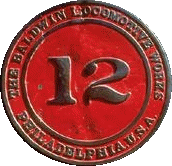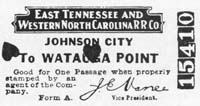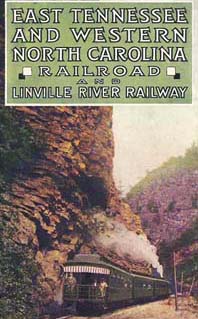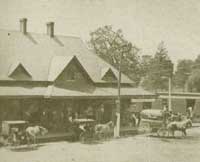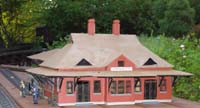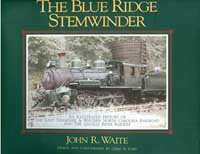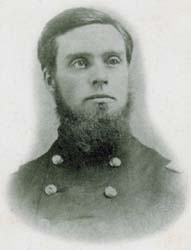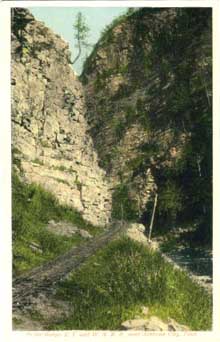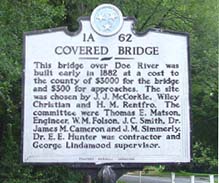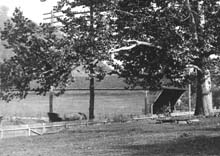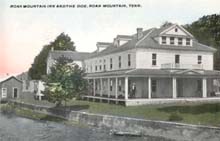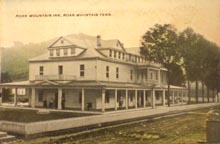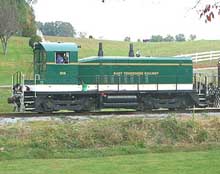Talk about a legendary railroad, the East Tennessee & Western North Carolina was one unique narrow gauge railway originating from Johnson City, Tennessee and eventually extending to Boone, North Carolina, a distance of 65 miles. Dubbed the "Railway with a Heart" - the railroad personnel were known to do shopping for mountain residents of Roan Mountain or Elk Park while in Johnson City and often to carry passengers for free during the Great Depression - "We are going that way anyway, come along and ride...."
Tickets were validated with a heart-shaped punch that signified the spirit and service provided by the railway to generations of Appalachian residents. Nicknamed the "Tweetsie" for its shrill whistle that echoed through the mountains, ET&WNC was affectionately also called "Eat Taters and Wear No Clothes." The ET&WNC passenger service operated from 1882 until 1950 and for a period time was the primary means for portions of mountainous Eastern Tennessee and Western North Carolina to have contact with the "outside world."
Originally chartered in 1866 by the Tennessee General Assembly, the ET&WNC was not completed from Johnson City to Cranberry, North Carolina until 1882 after much difficulty and years of financial challenges. To navigate the difficult Blue Ridge Mountain terrain, the road was built to a "narrow" gauge design of 3-feet rail widths rather than the American standard gauge rail width almost two feet wider. The trip featured incredible scenic beauty and the railway was completed by Pennsylvania-based financier Ario Pardee and the noted railway engineer, Thomas Matson who later served as Mayor of Johnson City from 1892 to 1894. Matson also was founder and first President of the Johnson City Foundry and Machine Works (See 1886 Ad for the Foundry) and designed the landmark Elizabethton Covered Bridge in 1882.
Iron forges existed well before the Civil War in the vicinity of Cranberry, North Carolina where the largest vein of iron ore in the U.S. had been discovered up to that time. During the war iron was produced for the Confederate Army at Cranberry. In 1873, Ario Pardee and his associates purchased the iron works and formed the Cranberry Iron & Coal Company. Pardee also purchased the abandoned ET&WNC railway line and essentially built the railway line from 1879 through 1882, an impressive engineering and construction feat. The ET&WNC connected to the East Tennessee Virginia and Georgia Railroad (later Southern Railway) in Johnson City and both railways shared the same Johnson City depot from 1891 through 1912. Completion of the ET&WNC was a major factor in Johnson City's growth from a village of 685 persons in 1880 to a town with a population of 4,161 in 1890. Jordan C. Hardin, an original investor in the ET&WNC and on the Board of Directors, was a key local connection in the railway's early development and his son, George W. Hardin, managed the narrow gauge line from 1900 until his death in 1922.
In Johnson City industrialist and former Union Civil War General John T. Wilder led a team of investors bent on establishing Johnson City as a major iron and steel manufacturing center during the 1880s. Located near both the Cranberry Mines in North Carolina and the coal fields of Virginia, Kentucky, and West Virginia, Johnson City was seen as a strategic crossroads and transfer point for Appalachian mining interests and related transportation ventures. Wilder constructed the Carnegie (later Cranberry) Furnace in East Johnson City and founded the Carnegie Land Company. However, discovery and opening of the Mesabi iron region of Minnesota produced a glut of iron on the market, depressed iron prices dramatically, and negatively affected the profitability of the Cranberry Mines and Wilder's investments. Read a biography of General John T. Wilder.
Following the financial failures of the Wilder companies during the 1890s, the Cranberry Furnace was finally completed in 1902 and iron ore shipments from the Cranberry Mines to Johnson City gave the small ET&WNC Railway a core business through World War I. In addition to foundries and related iron works, Johnson City had a large number of hardwood and furniture manufacturing interests also dependent upon the ET&WNC and other railways for raw materials.
Railway service was extended from Cranberry to Boone, North Carolina in 1919. At a banquet in honor of the opening of the line into Boone, a gentleman of that area was asked to speak. He said “I remember when the only way a person could get to Boone was to be born there.” This was an accurate statement of the virtual isolation of many mountainous areas prior to railroad accessibility. A major flood in 1940 washed out the "Linville River Railroad" which connected Boone to the ET&WNC and that portion of the line was never rebuilt. Both the ET&WNC and Linville River railway routes attracted significant numbers of tourists and sight-seeing excursions due to the region's breath-taking scenery.
The huge Bemberg and Glanzstoff rayon plants in Elizabethton, Tennessee were major customers of the Tweetsie for decades as the ET&WNC played a major part in the daily life in East Tennessee and Western North Carolina and a crucial role in the region's development for almost a century. From the 1950s to 2002, the Railway operated primarily between Elizabethton and Johnson City serving important industrial customers. Continuing operations today as the East Tennessee Railway, the short line railroad now provides a variety of switching functions for the CSX and Southern Railways in Johnson City, Tennessee and has a well established customer base.
When you see the green diesel engine of the East
Tennessee Railway in and around the downtown and Carnegie sections
of Johnson City, keep in mind the history behind the legendary ET&WNC
narrow gauge railroad and the vital role this railroad played in the historic
development of the region it served. In addition to the existing East
Tennessee Railway, a small portion of the original route is preserved
via the Doe River
Gorge Railway operated by Doe River Gorge Ministries near Hampton,
Tennessee. The family-oriented tourist destination, the Tweetsie Railroad Theme Park in Blowing Rock, North Carolina also commemorates the spirit and heritage of this great mountain railroad.
Johnson's Depot is pleased to host the Cy Crumley Scrapbook, an online collection of historic photos and stories about the ET&WNC (Tweetsie) Railroad.
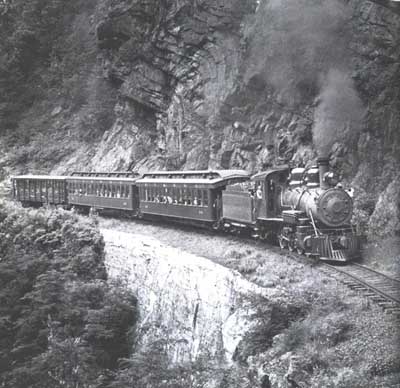 |
|
Doe River Gorge on the ET&WNC: What a ride!!! |
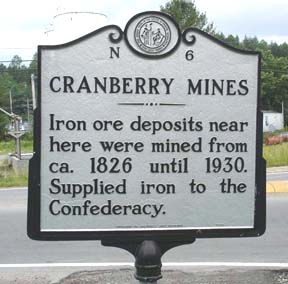 |
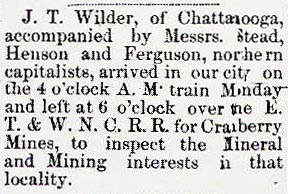 |
Johnson
City Enterprise April 7, 1883 |
|
| The Cranberry Mines,
located just across the North Carolina State Line about 8 miles
east of Roan Mountain, Tennessee were thought to contain the richest
deposit of magnetic iron ore in America prompting the construction
of the ET&WNC Railroad. Attention from major capitalists including industrialist and former Civil War General John T. Wilder and Andrew Carnegie resulted from the quality of iron deposits at Cranberry, North Carolina. |
|
 |
|||
| Commemorative
Coin from Thomas E. Matson Masonic Chapter |
|||
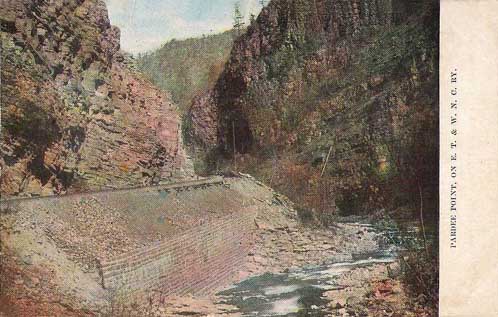 |
|||
Pardee Point
on the ET&WNC Back of Postcard Published by J.E. Crouch, Johnson City Bookseller and Publisher of Many Classic Postcard Scenes |
|||
 |
|||
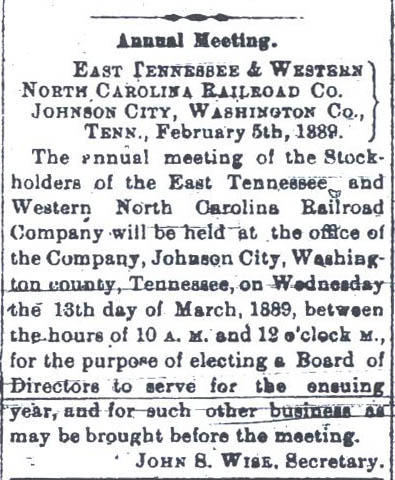 |
|||
|
|||
|
|||||||||||||||||||||||||
|
|||||||||||||||||||||||||
|
Links
|
